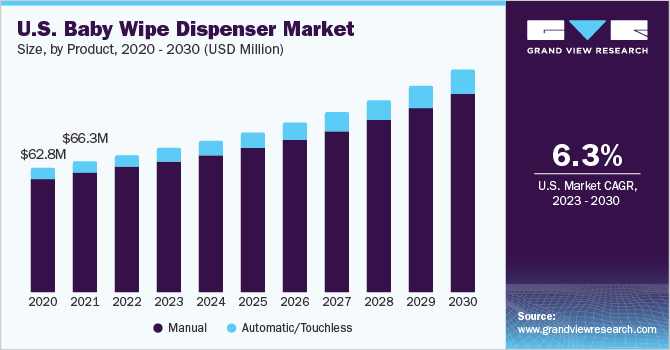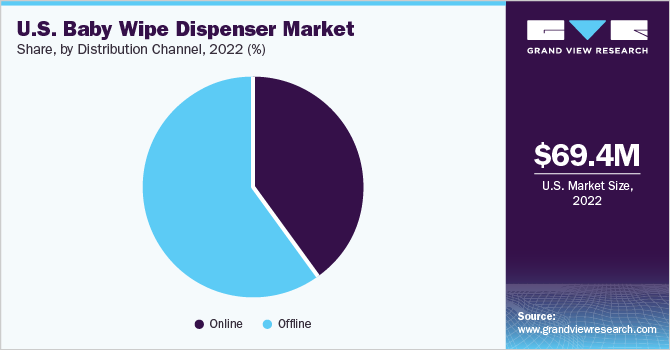- Home
- »
- Electronic & Electrical
- »
-
U.S. Baby Wipe Dispenser Market Size, Share Report, 2030GVR Report cover
![U.S. Baby Wipe Dispenser Market Size, Share & Trends Report]()
U.S. Baby Wipe Dispenser Market Size, Share & Trends Analysis Report By Product (Manual, Automatic/Touchless), By Distribution Channel (Online, Offline), And Segment Forecasts, 2023 - 2030
- Report ID: GVR-4-68040-061-5
- Number of Report Pages: 75
- Format: PDF, Horizon Databook
- Historical Range: 2017 - 2021
- Forecast Period: 2023 - 2030
- Industry: Consumer Goods
Market Size & Trends
The U.S. baby wipe dispenser market size was valued at USD 69.4 million in 2022 and is expected to grow at a compound annual growth rate (CAGR) of 6.3% from 2023 to 2030. This growth can be attributed to the increasing awareness about hygiene and convenience in baby care, as well as the rising number of working parents who are looking for products that make their lives easier.

Sustainability is an increasingly important trend in the baby wipe dispenser market. Consumers are becoming more environmentally conscious and are looking for eco-friendly baby products. As a result, many manufacturers in the baby wipe dispenser market are incorporating sustainability into their product design and marketing strategies. One way that manufacturers are addressing sustainability concerns is by using sustainable materials in their products. For example, bamboo is commonly used in baby wipe dispensers. Recycled plastic is also being used to make baby wipe dispensers, reducing the amount of plastic waste in the environment.
According to The Center for American Progress, in 2020 families in the U.S. have to spend an average of US$ 16,000 per year to cover the cost of child care. The high cost of childcare can have significant financial impacts on families, particularly for those with low or moderate incomes. According to the EPI report, childcare costs can consume as much as 35% of a family's income, making it difficult for parents to save money or invest in their own education or career development. This could act as a challenge in the growth of the baby wipe dispenser market.
Moreover, some manufacturers are also designing their products with refillable or reusable features, which reduce the amount of waste generated from single-use products. This approach allows consumers to reuse the dispenser and purchase refill packs of wipes, which creates less waste compared to traditional packaging options. In addition, some manufacturers are also exploring ways to reduce the environmental impact of the production process itself. For example, they may use renewable energy sources or implement recycling programs for materials used in production.
Overall, the sustainability trend in the baby wipe dispenser market reflects a broader shift towards eco-friendly and sustainable products across the consumer goods industry. As consumers become more environmentally conscious, they are demanding products that align with their values, and manufacturers are responding by developing products that are both effective and sustainable.
Product Insights
The manual baby wipe dispensers are leading the U.S. product market by holding a revenue share of 91.2% during the forecast period. They are generally more affordable than automatic or electric dispensers. This makes them a popular choice for cost-conscious consumers who are looking for a basic and functional product.
Second, manual dispensers are easy to use and require no special training or technical knowledge. Consumers can simply pull the wipes from the dispenser and use them as needed, without any additional steps or settings to adjust. This ease of use is particularly important for parents who may be juggling multiple tasks at once and need simple products.
The convenience factor is a major driver of demand for automatic dispensers. Automatic dispensers are expected to accelerate at a CAGR of 6.8% during the forecast period. With an automatic dispenser, parents do not need to physically pull the wipes out of the dispenser, which can be a time-consuming and messy process.
Instead, the wipes are dispensed automatically with the push of a button, making it a more convenient option for parents who are juggling multiple tasks at once. Automatic dispensers offer more precise control over the number of wipes dispensed. This can help reduce waste and save money in the long run, as parents can dispense just the right number of wipes needed for each diaper change or cleaning task.
Distribution Channel Insights
With a market share of almost 59.7% in 2022, the offline distribution channel is the leading market for baby wipe dispensers in the U.S. market. Buying baby wipe dispensers from an offline store provides consumers with the opportunity to physically touch and feel the product before making a purchase. This is particularly important for baby products, where parents often have specific requirements for the product such as the size, material, and ease of use. Being able to examine the product in person can help consumers make more informed purchasing decisions.

The online distribution channel for wipe dispensers has a wide scope due to its convenience, wide variety of products, availability 24/7, competitive pricing, reviews and ratings, and delivery options. These factors have contributed to the growing popularity of online shopping for baby wipe dispensers, and it is expected to continue to grow in the future by accelerating at 7.9%.
Online shopping is convenient as consumers can browse and purchase products from the comfort of their homes, without the need to physically visit a store. This is particularly important for parents who may have limited time and find it difficult to leave the house with a baby. Online channels offer a wide variety of products from different brands, sizes, and price points. This enables consumers to compare and select the product that best suits their needs, without any geographical limitations.
Key Companies & Market Share Insights
The market is greatly influenced by established players who have extensive distribution networks worldwide to cater to their large customer base. To strengthen their global presence and increase revenue, the main companies operating in the baby wipe dispenser market in the U.S. are emphasizing strategic efforts like introducing new products, expanding their reach, acquiring other companies, and participating in events. Companies in the market are focusing on introducing new products to address the evolving needs of parents and gain a competitive edge over other manufacturers.
For instance, in August 2021, Kimberly-Clark announced an expansion of its Huggies Rewards program, which allows parents to earn rewards for purchasing Huggies products. The new program includes more ways to earn rewards, such as by reviewing products or participating in surveys, and also offers more redemption options. Some prominent players in the U.S. baby wipe dispenser market include:
-
OXO
-
Prince Lionheart
-
Huggies
-
Ubbiworld
-
Carter’s, Inc. (Skip Hop)
-
Hiccapop
-
DEX PRODUCTS INC.
-
Munchkin, Inc.
-
Jool Baby
-
Baby Trend
U.S. Baby Wipe Dispenser Market Report Scope
Report Attribute
Details
Revenue forecast in 2030
USD 112.90 million
Growth rate
CAGR of 6.3% from 2023 to 2030
Base year for estimation
2022
Historical data
2017 - 2021
Forecast period
2023 - 2030
Quantitative units
Revenue in USD million and CAGR from 2023 to 2030
Report coverage
Revenue forecast, company ranking, competitive landscape, growth factors, and trends
Segments covered
Product, distribution channel
Country scope
U.S.
Key companies profiled
OXO; Prince Lionheart; Huggies; Ubbiworld; Carter’s, Inc. (Skip Hop); Hiccapop; DEX PRODUCTS INC.; Munchkin, Inc.; Jool Baby; Baby Trend
Customization scope
Free report customization (equivalent up to 8 analysts working days) with purchase. Addition or alteration to country, regional & segment scope.
Pricing and purchase options
Avail customized purchase options to meet your exact research needs. Explore purchase options
U.S. Baby Wipe Dispenser Market Report Segmentation
This report forecasts revenue growth at country levels and provides an analysis of the latest industry trends and opportunities in each of the sub-segments from 2017 to 2030. For this study, Grand View Research has segmented the U.S. baby wipe dispenser market report based on product and distribution channel:
-
Product Outlook (Revenue, USD Million, 2017 - 2030)
-
Manual
-
Automatic/Touchless
-
-
Distribution Channel Outlook (Revenue, USD Million, 2017 - 2030)
-
Online
-
Offline
-
Frequently Asked Questions About This Report
b. The U.S. baby wipe dispenser market size was estimated at USD 69.4 million in 2022 and is expected to reach USD 72.9 million in 2023.
b. The U.S. baby wipe dispenser market is expected to grow at a compound annual growth rate of 6.3% from 2023 to 2030 to reach USD 112.9 million by 2030.
b. Manual segment dominated the U.S. baby wipe dispenser market with a share of 91.18% in 2022.
b. Some key players operating in the U.S. baby wipe dispenser market include OXO, Prince Lionheart, Huggies, Ubbiworld, Carter’s, Inc.(Skip Hop), Hiccapop, DEX PRODUCTS INC., Munchkin, Inc., Jool Baby, Baby Trend.
b. Key factors that are driving the U.S. baby wipe dispenser market growth include increasing awareness of hygiene and convenience in baby care, as well as the rising number of working parents who are looking for products that make their lives easier
Share this report with your colleague or friend.
![gvr icn]()
NEED A CUSTOM REPORT?
We can customize every report - free of charge - including purchasing stand-alone sections or country-level reports, as well as offer affordable discounts for start-ups & universities. Contact us now
![Certified Icon]()
We are GDPR and CCPA compliant! Your transaction & personal information is safe and secure. For more details, please read our privacy policy.
We are committed towards customer satisfaction, and quality service.
"The quality of research they have done for us has been excellent."





